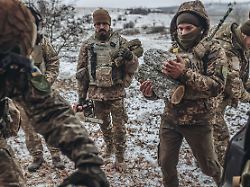Ground frost doesn’t help either
Continuous fire in Donbass prevented winter offensive
By Kevin Schulte
01/26/2023, 4:20 p.m
The battlefield in eastern Ukraine has changed. Less mud, more frozen floors. In theory, these are good prerequisites for a winter offensive. But that will probably never happen again, because Ukrainians and Russians are wearing each other down.
In mid-January, temperatures in the Donbass dropped to as low as minus 20 degrees. Even during the day, the thermometers showed a maximum of minus 5 degrees during this time. The conditions make the already hostile life on the war front even more hostile. But they also open up new possibilities for larger troop movements and winter offensives: Heavy war equipment can move much better and faster on the hard, frozen ground than in the autumn mud.
And constant plus straights are not to be expected in eastern Ukraine in the coming weeks. “That means there’s always frost at night anyway. During the day it’s always below zero degrees. In this respect, the ground stays frozen,” predicts ntv meteorologist Björn Alexander in the podcast “Learned again”.
Despite this, major offensive operations in eastern Ukraine are unlikely in the remaining winter months. Because the soldiers on both sides are now walking on the gums. For months they have been fighting a bloody battle of attrition, especially in the Donbass, without any major shifts at the front.
Reserves are being gobbled up in the Donbass
The Russians have recently taken the small town of Soledar and are still trying to conquer the larger Bakhmut as well. A larger offensive is not to be expected at the moment, analyzes security expert Nico Lange at ntv. “It has now taken Russia five months to conquer a small town of 10,000 people. We must not create such a mythological threat that Russia would have held back some huge forces in order to escalate further.”
Lange attests the Russians in Donbass “great difficulties”. It is all the more important “to support Ukraine so that it can end this war before Russia regroups.”
For the Ukraine, however, only smaller offensives seem possible. Kiev’s army is currently attempting to regain control of the Russian-held frontline towns of Svatove and Kreminna in the Luhansk region. That could help Ukraine cut off a key Russian logistics route. But it is not enough for more at the moment. The battle of attrition in the Donbass is simply eating up too many reserves for that.
The war is bloodiest in Bachmut
It is very likely that several thousand soldiers from both nations died on the Soledar-Bachmut front alone. Especially on the Russian side, high losses are said to be part of the war strategy: the Wagner mercenaries fighting for Russia are said to sacrifice thousands of fighters in order to overwhelm Ukraine. For the Ukrainians, it is about Russia using up as many soldiers and as much material as possible in its attacks, explains Colonel Markus Reisner of the Austrian Armed Forces on ntv. “Wagner’s recruitment also includes prisoners. That’s cannon fodder. That sounds very inhuman, and it is.”
“Learned again” is a podcast for the curious: Will Deutsche Bank get its money back from Donald Trump? Why do some commercial pilots pay money for their job? Why are pirates moving from East to West Africa? Listen in and get a little smarter three times a week. All episodes of “Again what learned” can be found in the ntv app, among other things AudioNow, Amazon Music, Apple Podcasts, Google Podcasts and Spotify.
Nowhere else is the Ukraine war as bloody as at Bachmut. But in the battle of attrition every success, no matter how small, demands a high price. Even Dennis Puschilin, head of the self-proclaimed Donetsk People’s Republic, annexed by Russia in violation of international law, had to admit that: When Soledar was taken, thousands of soldiers were wasted for a comparatively small town.
This limits the offensive options. It doesn’t matter if the ground is frozen or not. “The human factor is much more important than the vehicles that you can move in winter,” Ed Arnold said recently Bloomberg explained. The icier the weather, the more morale, mobility and logistics could fall by the wayside, said the former British officer.
And the weather conditions in eastern Ukraine cannot be compared to those in Germany, ntv meteorologist Björn Alexander makes it clear. “There have been many extremely cold phases this winter, even with double-digit minus degrees, especially at night. The conditions and temperatures are tougher than in Central Europe or in Germany.”
Defenders have an advantage in sub-zero temperatures
Very low temperatures only theoretically make offensive operations easier. In truth, defenders have an advantage, says Ed Arnold. If you’re on the defensive, it’s easier to stock up on groceries because you don’t move or move very little. With an advancing troop it is different. Soldiers on the offensive would have to be constantly supplied at changing locations, which complicates the logistics.
No major offensive is to be expected before spring. Until then, the Ukrainians and Russians will continue to wear themselves out on the hundreds of kilometers of Donbass front – even in freezing temperatures. “The forecasts of the American weather service predict a February that is far too mild, but also with really icy phases,” reports Alexander in “Wieder was Lern” (“Learned Again”). The European weather model, on the other hand, already shows permafrost with sometimes heavy snowfall in February. “There are still very icy weeks to come.”
Neither side can currently launch any major offensives anyway. The Ukrainians hope to be able to gain new penetrating power with the western main battle tanks. According to military strategists, the Russians are playing for time in order to be able to mobilize new soldiers and launch a larger attack in the spring.
